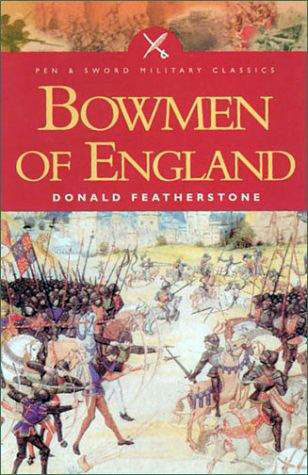
Donald Featherstone
The Bowmen of England
Barnsley, Yorkshire: Pen & Sword. 2003. 200 pp. PB $9.95usd. ISBN 978 0 0850 5294 63.
In light of the recent scholarly debate over the nature of the role and existence of the longbow in medieval warfare, participated in by such De Re Militari cornerstones as Clifford Rogers and Kelly DeVries, it is perhaps fitting that Donald Featherstone's classic work on longbows from 1968 should be republished during the last decade by Pen & Sword in no fewer than three printings. Featherstone's intent was to illustrate the significance of the longbow, as a unique and uniquely effective weapon, and the longbowman himself, as a versatile, courageous, invaluable soldier, in the context of late medieval English military engagements. Indeed, throughout the book, Featherstone demonstrates in multiple examples how archery and archers became the particular variables that allowed English armies to best heavy cavalry charges, Scottish schiltrons of spear-laden infantry, and squadrons of crossbowmen.
Featherstone organized his book, logically, in chronological fashion, tracing the development of the longbow from its incorporation into English military tactics in the thirteenth century to its final triumphs in the sixteenth as it yielded to gunpowder technology. Chapters are grouped into thematic sections, and the majority deal with individual battles in which the longbow proved instrumental for victory. Featherstone's strength appears to be his dramatic writing style and ability to explain battle strategy and narratives with astonishing vividness: the chapters unfold like a series of short, entertaining military stories. Additionally, the author has incorporated helpful maps illustrating battle positioning into several of his chapters.
Despite this, The Bowmen of England straddles an uneasy line between scholarly and popular history. There is, for example, a perplexing juxtaposition of elements that does not clearly delineate an intended audience. The book's short length, lack of notes or citations, and flowing narrative approach (including extensive fabricated dialogue[1]) seems to imply that Featherstone anticipated a more casual reader. However, there are often allusions to important people, writers, events and legislation (e.g., the Ordnances) that are not contextualized, cited or explained—things only specialists would understand. Perhaps the author assumed that the reader would already be familiar with such things.[2] Furthermore, Featherstone appears comfortable working with chronicle and other medieval sources, and on occasion quotes from them in Latin, without citation or sometimes even translation. (e.g., p. 25) The ambiguity is continued in the bibliography, which is skeletal at best, and while Featherstone has divided his sources into different "user-friendly" categories, they are unusual groupings in that, for example, primary sources are not separated from secondary sources as is the norm for scholarly works. Worse, many of the sources referred to or even quoted in the text of his book, including most of the chronicle and other medieval primary sources, are not listed in the bibliography at all.
One of the most troubling aspects of Featherstone's book is his reliance on modern fiction for some of his source material, especially the novels of Sir Arthur Conan Doyle. Despite Featherstone's overt disclosure of his use of the material, nowhere does he justify his use of such works, and indeed, there seems to be no evaluation on his part of whether such sources are even credible or appropriate. Moreover, the fact that Featherstone does not contextualize any of his sources when discussing them makes this reviewer concerned that the author did not evaluate the reliability and hence usefulness of any of his sources. Who, for example, was Ralphe Smithe, whose description of an archer (from the fifteenth century, if the spelling is any indication), is incorporated into Featherstone's text, and where did Featherstone find Smithe's writing? (pp. 48-9)
Overall, this reviewer is left with mixed feelings about The Bowmen of England. Certainly it is an engaging, enjoyable read, and for someone who is familiar with the majority of the references incorporated by Featherstone into the text, there is no trouble following along. However, this reviewer is unconvinced that this book is intended for an audience which largely has such familiarity with the subject matter, and therein lies the problem Was Featherstone successful in his goal of promoting the importance not only of the longbow, but also the archer himself, in late medieval English warfare? Absolutely. Nonetheless, Featherstone's methods in accomplishing such a goal were not as successful.
Notes
[1] The entire prologue of the book is a contrived scene with manufactured dialogue, no discussion of context, and no citation to corroborate the accuracy of such a description.
[2] Unfortunately, what one hopes is simply a small editorial error has rendered Andrew Harcla's name as "Harcia", which only someone familiar with early fourteenth century history would catch.
